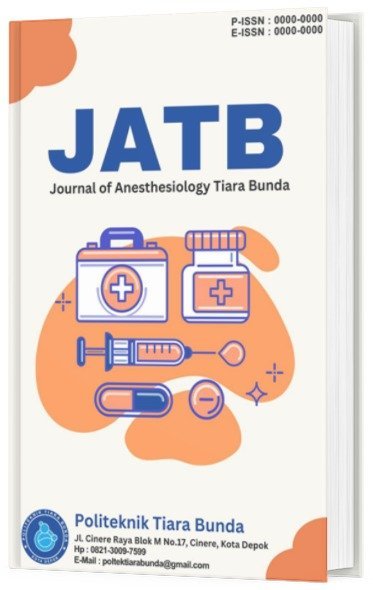GAMBARAN TINDAKAN PENCEGAHAN RISIKO KEJADIAN DEKUBITUS MUKOSA ORAL PADA PENGGUNAAN ENDOTRACHEAL TUBE DI RUANGAN INTENSIVE CARE UNIT DI RSUD KOTA DEPOK
Keywords:
Risk factors Oral mucosa pressure Ulcer, Oral mucosa pressure Injury, Intensive Care Unit, Medical Device Related Pressure UlcerAbstract
Background: Wound Decubitus related to the use of medical devices, one of which can occur in the use of the Endotracheal Tube (ETT),In general, patients treated at the Intensive Care Unit (ICU) have an Endotracheal Tube (Intubation) attached.
Destination: To know overview of risk precautions incidence of oral mucosal decubitus when using the Endotracheal Tube (ETT) in patients in the Intensive Care Unit (ICU)
Method: Quantitative research with descriptive research type with online survey method with cross sectional approach. The instrument used was a google form questionnaire risk factor sthe incidence of oral mucosal decubitus with the use of Endotracheal Tube (ETT) which consists of the ETT insertion technique, monitoring measures to minimize oral mucosal decubitus and handling oral mucosal decubitus. The sample in this study is the nurse in charge of the ICU. Sampling in research with nonprobability techniques with total sampling technique.
Result: ETT insertion technique variable There were 30 people (76.9%) in accordance with the Standard Operational Procedure and 9 people (23.1%) who were not. monitoring measures to minimize the incidence of oral mucosal decubitus were 29 people (74.4%) and 10 people (25.6%) were not carried then 27 people (69.2%) were treated for mucosal decubitus and 12 people (30.8%) were not done.
Conclusion : There are several risk factors that can lead to the development of oral mucosal decubitus sores, therefore caution and closer monitoring are needed in patients attached to an Endotracheal Tube (ETT).
Downloads
References
Beth, M., & Makic, F. (2015). Medical Device – Related Pressure Ulcers and Intensive Care Patients. Journal of PeriAnesthesia Nursing, 30(4), 336–337. https://doi.org/10.1016/j.jopan.2015.05.004
Black, J., Alves, P., Brindle, C. T., Dealey, C., Santamaria, N., Call, E., & Clark, M. (2013). Use of wound dressings to enhance prevention of pressure ulcers caused by medical devices. International Wound Journal, 12(3), 322–327. https://doi.org/10.1111/iwj.12111
Black, J. M., Cuddigan, J. E., Walko, M. A., Didier, L. A., Lander, M. J., & Kelpe,
M. R. (2010). Medical device related pressure ulcers in hospitalized patients, 7(5).
Black, J. M., & Kalowes, P. (2016). Medical device-related pressure ulcers, 91–99. Cooper, K. (2013). Evidence-Based Prevention of Pressure Ulcers, 33(6).
Cox, B. J., & Roche, S. (2015). Vasopressore and Development of Pressure Ulcer in Adult Critical Care Patients, 24(6).
Defloor, T. O. M. (1999). The risk of pressure sores : a conceptual scheme, (May 1998), 206–216.
Dyer, A. (2015). Clinical practice Ten top tips: Preventing device-related pressure ulcers, 6(1), 9–13.
Fisher, D. F., Chenelle, C. T., Marchese, A. D., Kratohvil, J. P., Rrt, L. P. N., Kacmarek, R. M., & Faarc, R. R. T. (2014). Comparison of Commercial and
Noncommercial Endotracheal Tube-Securing Devices, 1315–1323. https://doi.org/10.4187/respcare.02951
Haas, C. F., Eakin, R. M., Konkle, M. A., & Blank, R. (2014). Endotracheal tubes: Old and new. Respiratory Care, 59(6), 933–955. https://doi.org/10.4187/respcare.02868
Hampson, J., Green, C., Stewart, J., Armitstead, L., Degan, G., Aubrey, A., … Tiruvoipati, R. (2018). Impact of the introduction of an endotracheal tube attachment device on the incidence and severity of oral pressure injuries in the intensive care unit : a retrospective observational study, 1–8. https://doi.org/10.1186/s12912-018-0274-2
Hanonu, S., Karadag, A. (2016). Hanonu, S., Karadag, A., 2016. A prospective, descriptive study to determine the rate and characteristics of and risk factors for the development of medical devicerelated pressure ulcers in intensive care units. Ostomy Wound Manage. 62 (2), 12–22. Australian Critical Care, 6(1), 12–22. Retrieved from https://www.o-wm.com/article/prospective-descriptive-study- determine-rate-and-characteristics-and-risk-factors
Hunter, M., Kellett, J., Cunha, N. M. D., Toohey, K., Mckune, A., & Naumovski, N. (2020). Review Article The Effect of Honey as a Treatment for Oral Ulcerative Lesions : A Systematic Review, 5, 27–37. https://doi.org/10.14218/ERHM.2019.00029
Hyzy, R. (2020). Complications of the endotracheal tube following initial placement : Prevention and management in adult intensive care unit patients, 1–29.
Kim, C., Soo, M., Ja, M., Hee, H., & Jung, N. (2019). Oral mucosa pressure ulcers in intensive care unit patients : A preliminary observational study of incidence and risk factors. Journal of Tissue Viability, 28(1), 27–34. https://doi.org/10.1016/j.jtv.2018.11.002
Krupp, A. E., & Monfre, J. (2015). Pressure Ulcers in the ICU Patient : an Update on Prevention and Treatment, (January 2013). https://doi.org/10.1007/s11908-015- 0468-7
Kuniavsky, M., Vilenchik, E., & Lubanetz, A. (2020). Under (less) pressure – Facial pressure ulcer development in ventilated ICU patients: A prospective comparative study comparing two types of endotracheal tube fixations. Intensive and Critical Care Nursing, (xxxx), 102804. https://doi.org/10.1016/j.iccn.2020.102804
Laura E. Edsberg et al. (2016). Revised National Pressure Ulcer Advisory Panel Pressure Injury Staging System Revised Pressure Injury Staging System, 43(December), 585–597. https://doi.org/10.1097/WON.0000000000000281
Liu, J., Zhang, X., Gong, W., Fu, S., & Hang, Y. (2010). Correlations Between Controlled Endotracheal Tube Cuff Pressure and Postprocedural Complications: A Multicenter Study, 111(5), 1133–1137. https://doi.org/10.1213/ANE.0b013e3181f2ecc7
Marshall, J. C., Bosco, L., Adhikari, N. K., Connolly, B., Diaz, J. V., Dorman, T., … Zimmerman, J. (2017). What is an intensive care unit? A report of the task force of the World Federation of Societies of Intensive and Critical Care Medicine. Journal of Critical Care, 37, 270–276. https://doi.org/10.1016/j.jcrc.2016.07.015
Mohammed, H. M., & Hassan, M. S. (2015). Endotracheal tube securements: Effectiveness of three techniques among orally intubated patients. Egyptian Journal of Chest Diseases and Tuberculosis, 64(1), 183–196. https://doi.org/10.1016/j.ejcdt.2014.09.006
Molan, P., & Rhodes, T. (2015). Honey: A Biologic Wound Dressing, 27(6), 141– 151.
Mussa, C. C., Meksraityte, E., Li, J., Gulczynski, B., & Liu, J. (2018). SM Gr up SM Journal of Factors Associated with Endotracheal Tube Related Pressure Injury, (January 2018). https://doi.org/10.36876/smjn.1018
National Pressure Ulcer Advisory Panel. (2013). Best Practices for Prevention of Medical Device-Related Pressure Ulcers in Pediatric Population, (October), 2013.
Nursalam. (2017). Metodologi Penelitian Ilmu Keperawatan Pendekatan Praktis, Edisi 4, Salemba Medika, Jakarta, 4.
Pachá, H. H. P., Faria, J. I. L., Oliveira, K. A. de, & Beccaria, L. M. (2018). Pressure Ulcer in Intensive Care Units: a case-control study. Revista Brasileira de Enfermagem, 71(6), 3027–3034. https://doi.org/10.1590/0034-7167-2017-0950
Ramadhan, H. N. (2019). Artikel Penelitian Pelaksanaan Pencegahan dan Pengendalian Ventilator Associated Pneumonia ( VAP ) di Ruang ICU, 01, 3–8.
Reis, M. E. (2013). Unplanned Extubation in the Neonatal ICU : A Systematic
Review , Critical Appraisal , and Evidence-Based Recommendations, 1237– 1245. https://doi.org/10.4187/respcare.02164
Schrementi, M. E., Ferreira, A. M., Zender, C., & Dipietro, L. A. (2008). Site-specific production of TGF- b in oral mucosal and cutaneous wounds, 80–86. https://doi.org/10.1111/j.1524-475X.2007.00320.x
Shah, V. R. (2014). A comparison of conventional endotracheal tube with silicone wire-reinforced tracheal tube for intubation through intubating laryngeal mask,
(2). https://doi.org/10.4103/1658-354X.130702
Szmuk, P., Ezri, T., Evron, S., Roth, Y., & Katz, J. (2008). A brief history of tracheostomy and tracheal intubation, from the Bronze Age to the Space Age. Intensive Care Medicine, 34(2), 222–228. https://doi.org/10.1007/s00134-007-0931-5
Teegardin, C., & Whitney, J. D. (2012). Retrospective Review of the Reduction of Oral Pressure Ulcers in Mechanically Ventilated Patients, 35(3), 247–254. https://doi.org/10.1097/CNQ.0b013e3182542de3
Yaghoobi, R., & Kazerouni, A. (2013). Evidence for Clinical Use of Honey in Wound Healing as an Anti-bacterial , Anti-inflammatory Anti-oxidant and Anti- viral Agent : A Review, 8(3).
Yamashita, M., & Nishio, A. (2014). Intraoperative Acquired Pressure Ulcer on Lower Lip : A Complication of Rhinoplasty Combined With Giant Divided Nevus of the Eyelid, 25(1), 12–13. https://doi.org/10.1097/SCS.0b013e3182a2ec23
Yoon, J., Yun, K., Lee, J., Association, K., & Continence, O. (2019). Medical device- related pressure ulcer ( MDRPU ) in acute care hospitals and its perceived importance and prevention performance by clinical nurses, (September 2018), 51–61. https://doi.org/10.1111/iwj.13023.
Downloads
Published
Issue
Section
License
Copyright (c) 2022 Sofwan

This work is licensed under a Creative Commons Attribution-ShareAlike 4.0 International License.










